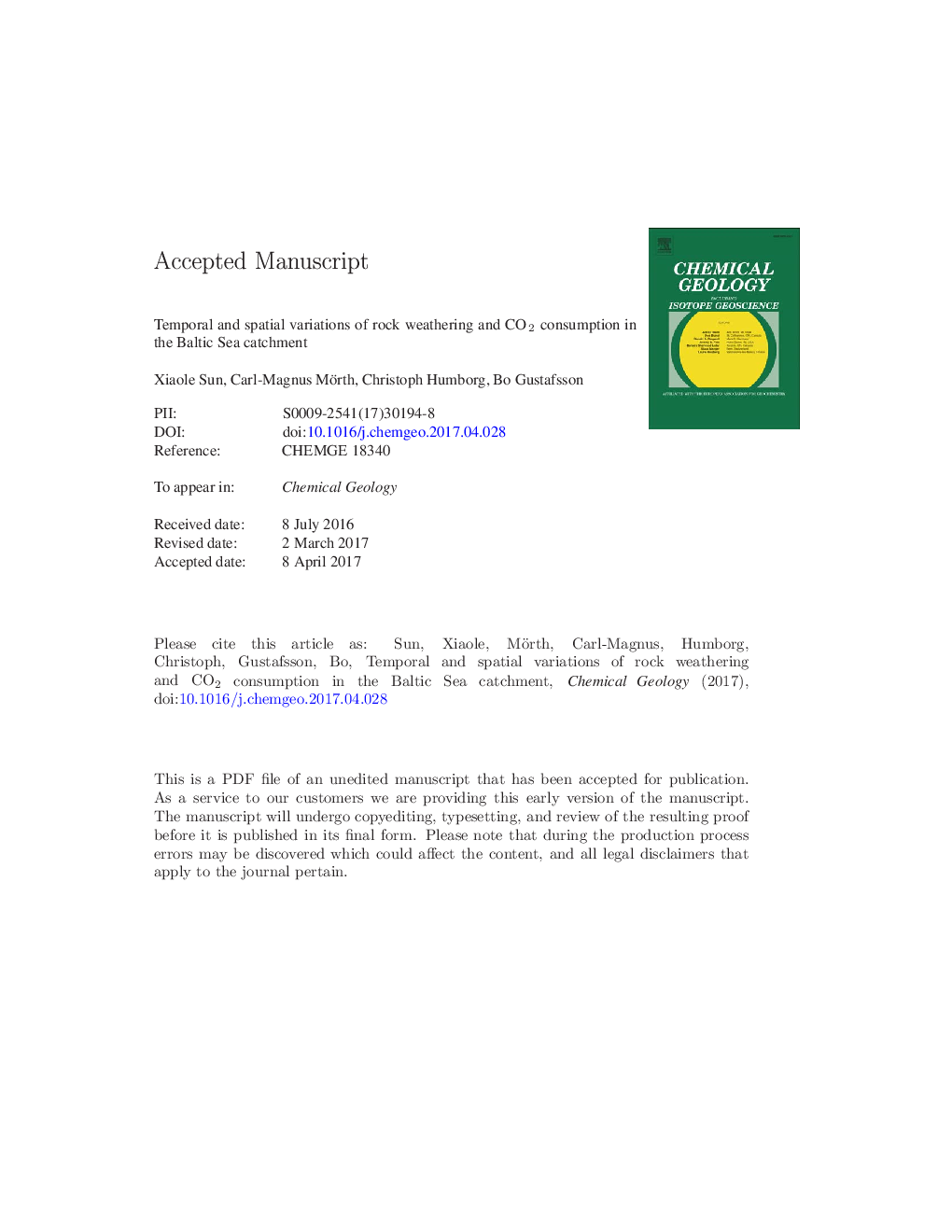| کد مقاله | کد نشریه | سال انتشار | مقاله انگلیسی | نسخه تمام متن |
|---|---|---|---|---|
| 5782818 | 1637508 | 2017 | 54 صفحه PDF | دانلود رایگان |
عنوان انگلیسی مقاله ISI
Temporal and spatial variations of rock weathering and CO2 consumption in the Baltic Sea catchment
دانلود مقاله + سفارش ترجمه
دانلود مقاله ISI انگلیسی
رایگان برای ایرانیان
موضوعات مرتبط
مهندسی و علوم پایه
علوم زمین و سیارات
ژئوشیمی و پترولوژی
پیش نمایش صفحه اول مقاله

چکیده انگلیسی
This study provides the first estimate of silicate and carbonate weathering rates and derived CO2 consumption rates for the Baltic Sea catchment using river chemistry data of 78 rivers draining into the Baltic Sea. The silicate weathering rates (denoted as total dissolved solids) of individual river basin range from 0.014 Tg/year to 4.55 Tg/year and the carbonate weathering rates range from 0.079 Tg/year to 6.49 Tg/year. The total CO2 consumption across the Baltic catchment is approximately 3.9 Tg C/year and is almost equally shared by silicates and carbonates. Uncertainty associated with the weathering estimate is around 32%, which is mainly caused by incomplete pollution correction for a few major rivers in the south. The calculations for the boreal river basins have higher certainties because of less human impacts. The CO2 consumption rate of individual river basin vary between 0.53 and 5.66 g C/m2/year with an average of 2.97 g C/m2/year, in which carbonates consume CO2, 1.4 g C/m2/year and silicates take 1.5 g C/m2/year. This is in the same range as has been reported for the Mackenzie River and Siberian river basins, but at the lower range of tropical rivers, suggesting the Baltic Sea catchment holds solid weathering signals for high-latitude systems, especially in the pristine boreal silicate-dominated areas. The amount of CO2 consumed by weathering in the Baltic Sea catchment accounts for approximately 3-30% of the net ecosystem carbon exchange (10-100 g C/m2/year), implying that weathering contributes as a significant sink of atmospheric CO2. Although many studies have shown the positive relation between temperature and weathering rates in various river catchments, multiple regression analysis using the 40-year continuous records of river chemistry in the boreal area of the Baltic Sea catchment reveals a strong correlation between weathering flux and precipitation, but no statistically significant correlation between weathering and temperature. This suggests not only that temperature is not necessarily to be primary controlling factor for weathering rates, but also besides precipitation, other factors, like increased soil organic matter contents and water path changes may have high impact on weathering rates. The 40-year data analysis also shows generally increasing weathering fluxes by 10-20% in the pristine boreal area over the past decades. This indicates that increased CO2 consumption by weathering and the resulting elevated dissolved inorganic carbon delivery to the ocean act as a negative feedback for ocean acidification, such as the Arctic Ocean that has become more acidic due to high terrestrial organic carbon delivery together with increased river water input.
ناشر
Database: Elsevier - ScienceDirect (ساینس دایرکت)
Journal: Chemical Geology - Volume 466, 5 September 2017, Pages 57-69
Journal: Chemical Geology - Volume 466, 5 September 2017, Pages 57-69
نویسندگان
Xiaole Sun, Carl-Magnus Mörth, Christoph Humborg, Bo Gustafsson,